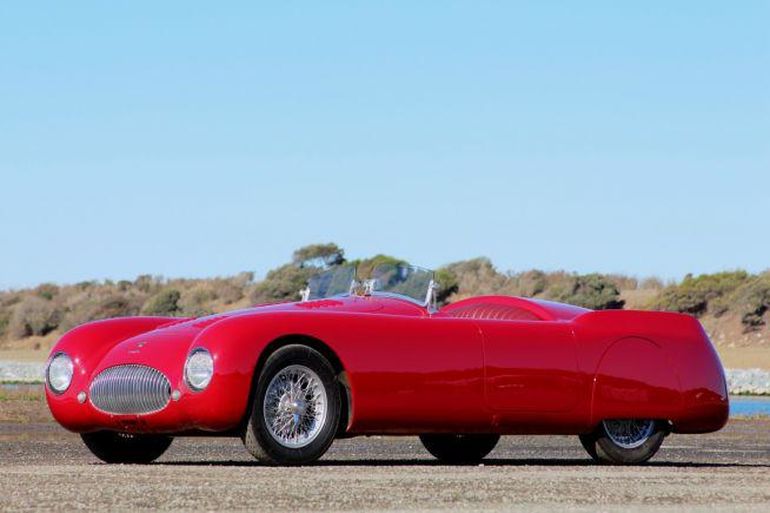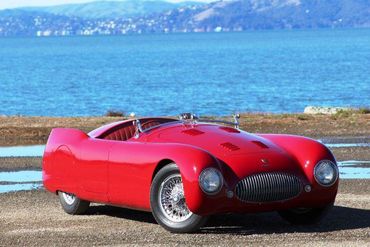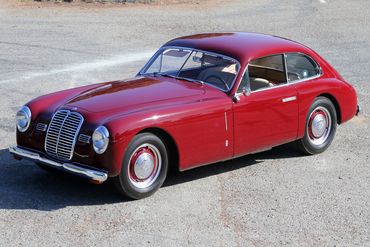Sold
SOLD 07/16
1947 Cisitalia
202SMM Nuvolari Spyder
Rare and Desirable, Numbers-Matching Cisitalia 202 Spyder with Period Mille Miglia History.
- VIN003S
- Exterior ColorDark Red
- Interior ColorRed Leather
- Mileage21459 Miles
- Engine1100 c.c. 4-Cylinder
- Engine no.031MM
- Transmission4-Speed Manual
- StatusSold
- StockFJ1864
Description
1947 Cisitalia 202SMM “Nuvolari” Spyder
s/n 003S, Engine no. 031MM
Dark Red with Red Leather
The Cisitalia 202 is a fascinating, hand-built car created by Piero Dusio’s Compagnia Industriale Sportiva Italia (CISItalia), a company he started in the days leading up to World War II. Dusio, a well-known soccer star and astute businessman began his manufacturing career producing sporting equipment, military uniforms for the war effort, other textiles, and he also dabbled in banking.
His automobile racing career began in 1930 when he raced an O.M. spider Zagato in the Mille Miglia of that year. He switched quickly to Alfa Romeo cars and often purchased used or even well-used cars from other racers. Beginning in the mid-1930's he raced a few Maseratis and, in 1937, he won the Sport 750 category in the Mille Miglia aboard a Zagato-bodied Fiat-Siata 500. He developed a healthy respect for smaller, moderately powered, long-distance capable cars from that experience and even though he would continue to race larger vehicles, the concept for producing his own competitive, small-bore vehicle was born.
During wartime, when work was often slow in the design offices at Fiat, Dusio asked Dante Giacosa to moonlight on a single-seater racing car design project that he named the \"Tipo 201\". That design would eventually develop into the well-known, post war, single seater racer known as the \"D46\" (for Dusio, 1946). When Giacosa was asked to return to Fiat shortly after hostilities ceased, Dusio sought additional design help. He recruited Giovanni Savonuzzi, an aeronautical engineer from Fiat, to do additional development on the Tipo 201 concept. The resulting \"D46\" was launched as a “one-class” racer that would highlight the talent of the drivers rather than the relative merits of different manufacturer’s designs. In 1946, seven D46s made Cisitalia’s competition debut at the Coppa Brezzi and Dusio himself won the race driving one, and many of the great drivers of the day took to the track behind the wheel of a D46.
The engine, based nominally on Fiat-produced castings, was specially prepared with custom parts and period racing tricks such as dry-sump lubrication and performance-enhancing carburetors from Zenith-Torino mounted on a special manifold. The engine is quite special as Cisitalia sought to realize reliable power increases rather than build short-lived engines that were over-stressed. With the light weight of the D46, the Fiat based four-speed gearbox was re-engineered to become a three-speed pre-selector gearbox that allowed the driver to select the next gear needed before needing to shift. A lever was moved when convenient, and the shift took place automatically, allowing both hands to remain on the steering wheel. A clever quick-change gear package allowing for quick ratio changed completed this clever, competitive package.
As the Tipo 201/D46 project matured, a widened two-seater version of the tubular chassis was designed and designated as the \"Tipo 202\". This chassis formed the basis of a series of cars that were intended both for racing and as gentleman's GT road cars. The racing version became known as \"Sport\" and the designation was \"Tipo 202S\" and then \"Tipo 202SMM\".
When Tazio Nuvolari finished second overall in a Cisitalia 202S (chassis \"001A\") in the 1947 Mille Miglia (and very nearly won the race over far more powerful cars until an electrical problem caused considerable time to be lost), Dusio contracted with Nuvolari for the use of his name on his racing model. Nuvolari was paid quite handsomely to have his name used on a few subsequent production versions of the \"202SMM\" and they became known as \"Spyder Nuvolari\". While Nuvolari’s driving prowess certainly helped the car’s placement in that famous race, other Cisitalia’s also placed 3rd and 4th overall behind Nuvolari’s stunning 2nd place effort. The cars were seriously competitive.
This particular example, s/n 003S is a matching-numbers 202 with fascinating history. While the original Italian paperwork designated this as a 1947 production vehicle, the car was first sold officially on 6 October 1948 with engine 031MM (still present in the car) to the Turinese business owner, Luigi Bedosti. It is possible that this car was sold to Bedosti as a result of having been displayed at the Salone Internazionale dell'Automobile (in Turin) that ran from 15 to 26 September of 1948. The car was first registered 12 October in Turin with engine \"031\" and there is no indication that Bedosti did any racing with it.
The car was then sold 14 April 1949 to Mario Bortolotti of Bologna \"just in time\" for Bortolotti to race it in the 1949 Mille Miglia (24 April 1949), where it did not finish. Photos and other research tell us that it got at least as far as Florence, still wearing Bedosti's plates from Turin.
The car was re-registered in Bologna on 6 September 1949 just before being sold to Aldo Medri of Cesena, where the car was re-registered on Forli' plates. The car passed almost immediately to Armando Bevilacqua in Bologna and was re-registered in Bologna on 22 September 1949. Armando Bevilacqua raced also chassis 004S (a special 202S called \"Il Razzo\") during August of 1949, and it is very likely that \"003S\" was also used by Bevilacqua on the Bologna - Raticosa Hillclimb of 17 September 1950, where he was 20th overall and 10th in the Sport 1100 category.
This car was then sold on 2 May 1951 to Mario De Boni of Trieste and was re-registered on Trieste plates, and De Boni raced 003S in at least four events during 1951. For the Mille Miglia of 1952, the car appeared with the body in raw aluminum with an engine-turned finish and with a custom, Perspex bubble roof that was quite amazing visually. Following the Mille Miglia (where the car failed to finish) and at least one more event in \"closed\" form, the car was returned to its former \"spyder\" form and De Boni continued to race it no less than eight times from 1952 to 1957, most frequently on the local \"Trieste - Opicina\" hillclimb. The car also made period appearances at the Rallye Nuvolari, the Supercortemaggiore, the Coppa d’Oro Dolomiti, among others, often placing or winning its class.
In summary, chassis number 003S it very likely the most raced 202 Cisitalia extant, having been highly active in international events from 1948 well into the late 1950's.
The car was sold 1958 to the next owner, also in Trieste. By the time the car turned up again in the 1980's, the body was fragile and tired due to over a decade of hard, competitive use and was removed, although the chassis and mechanical package were still together and quite complete.
The car then passed to Nino Balestra, author of what is probably the first definitive book about Cisitalia cars, and the holder of most of the remaining Cisitalia archives. The restoration project was sold to a new owner and Nino continued to consult on the restoration. A new body was made by Dino Cognolato's \"Carrozzeria Nova Rinascente\". That work was finished by May of 1999 and the fully restored car was sold later that year to Japan. The car came to a new owner in the USA during 2011 and is now being offered here.
Of five 202 \"Sport\" chassis known to have been built, only three of which were truly in the form known later as \"Spyder Nuvolari\" ... all three examples exist. This is evidence of how special these cars have always been to their owners. We do not yet know how many additional \"Nuvolari\" examples were built, but only fourteen seem to be numbered in what might be thought of as an independent \"202SMM\" series numeration while perhaps another four examples are known to have been numbered among the normal 202 production. This count implies that roughly 21 similarly configured cars were built, although the total number might grow as a few cars turn up over time. In any event, this model is exceedingly rare and each example can easily be thought of as unique given the hand-built nature combined with the specific racing history.
Cosmetically, the car is beautifully presented. While clearly not enjoyed solely on the concours lawn, s/n 003S remains sharp enough in its restoration details and would likely garner considerable attention based on its rarity and dynamic visual characteristics.
The body, paint, and brightwork and all nearly unmarked, and are generally outstanding. The Spartan but functional and ergonomically pleasant interior shows just the slightest signs of age and use, as would be expected of an open cockpit event car. The rear storage area is also very nice, showing just a few signs of light use on road rally events. The engine bay is beautifully detailed and has a crisp and purposeful appearance. The polished Cisitalia valve cover is very cool and in very good shape. The underside is well restored and in good order, but is perhaps a step away from the cosmetic presentation achieved by the interior and exterior of the car.
This is an exceptional opportunity to acquire a rare and desirable, numbers-matching Cisitalia 202 Spyder with period Mille Miglia history. Exceedingly rare cars to begin with, this example is matching-numbers and has fascinating history dating back to its early days. It is fantastically documented in several history books and comes with some rare period photos, as an extremely rare, original Cisitalia 202 owner's manual, an original Cisitalia brochure, two original bronze Mille Miglia participant medals and a brand new tool-room replica of the spyders steering wheel. The Cisitalia Society had a run of 3 or 4 of these made about 7 years ago and the current owner purchased the last one after he bought the car. The wheel is a perfect reproduction, including the cork grip and the center Cisitalia emblem.
Widely event eligible, from the Mille Miglia retrospective to the Lemans Classic, this example represents an outstanding opportunity to participate in some of the world’s most renowned events. In short, this car is everything that a high caliber classic should be: beautiful, rare, suitable for competition or standard road use, and widely event eligible, and this example is further distinguished by its history, documentation, and matching-numbers status.
The above vehicle information is complete and accurate to the best of our knowledge at the time it is posted to this website. Corrections or additional information is always appreciated. All advertised prices exclude government fees and taxes, any finance charges, any dealer document preparation charge, and any emission testing charge. Vehicles are subject to prior sale. All advertised to be true but not guaranteed. We assume no liability for errors or omissions.
Inquire About This Car
Fantasy Junction • 510-653-7555 • 1145 Park Ave, Emeryville, CA 94608





